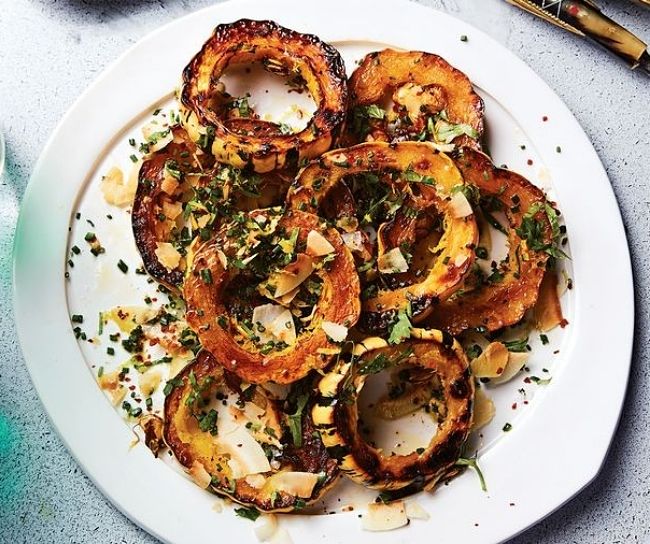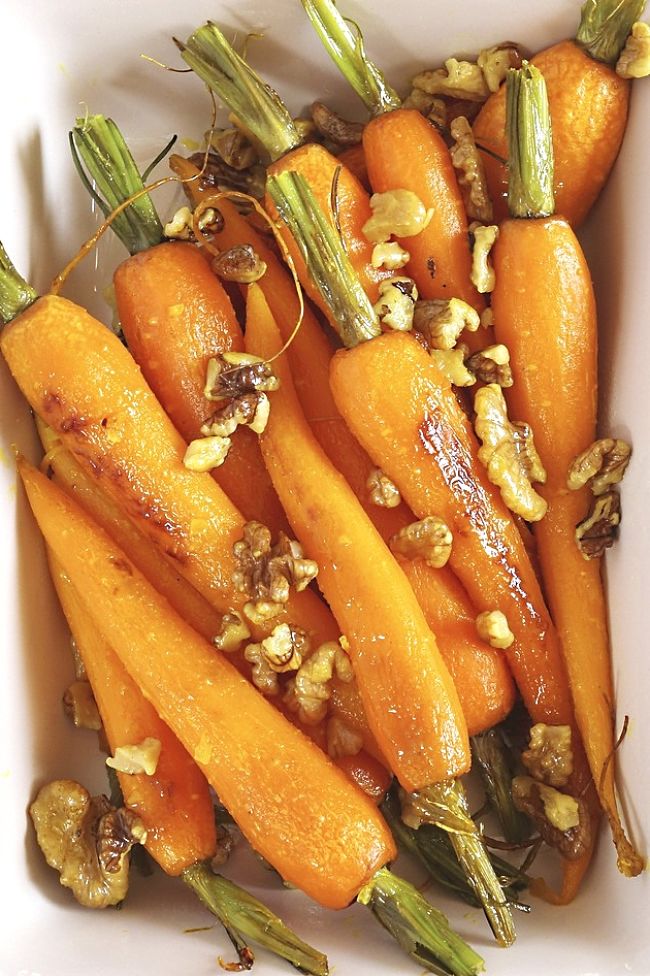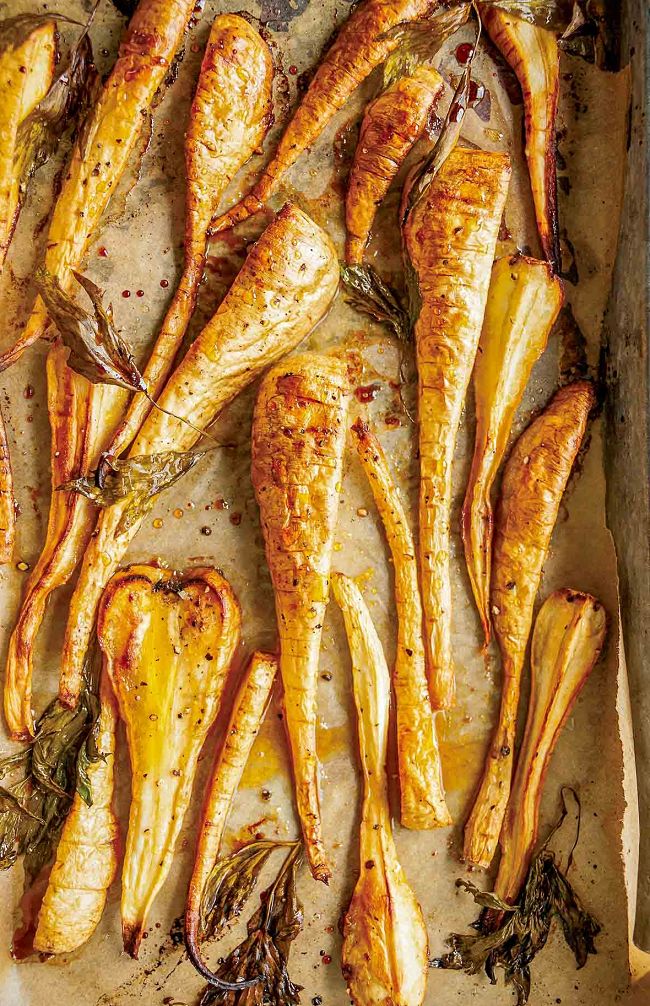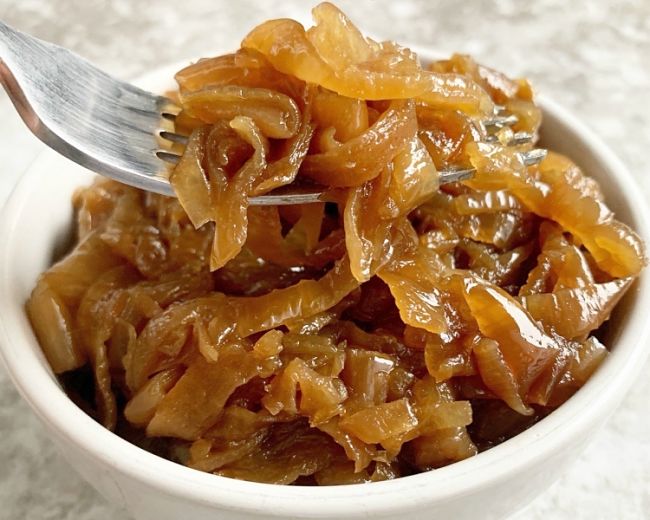How to Caramelize Vegetables to Enhance Their Flavor, Color and Appeal
The word "caramel" may mistakenly be taken to mean sweet, sugary or high in calories. The process of caramelization refers to the browning of sugar that occurs naturally in the food. Or tiny amounts of sugar are added in the form of glucose, fruit juice concentrate, sucrose, honey or molasses.
Caramelizing creates a sweet nutty flavor to the food, and generally turns the food to a brown color (they turn 'caramel'). The food is effectively covered in a caramelized sauce or dressing. It requires high temperature from a grill, pan or oven to caramelize the sugar.
Most vegetables and fruit, which have their own sugars, will caramelize well when exposed to high temperatures. Sweet fruit like pineapples, figs, peaches, and bananas will caramelize very well. Most vegetables have enough sugar to caramelize, though you can hasten and enhance the process by adding small amounts of sugar, syrup or honey. The trick to finding the best vegetables for caramelizing, is to find varieties have the most natural sugar. Obviously, many of the best ones are bulbs or root vegetables. Some good choices are carrots, beets, parsnips, onions, peppers, pumpkin squash and corn.
Another trick is to cut the vegetables so that a large surface area is exposed to the flame, grill, pan or heat in the broiler of oven. This will hasten the process. Using a flame is a quick way to caramelize vegetables, but you can use searing in a pan, grilling on a hot plate, broiling or roasting in the oven. Remember to spread the vegetables in a shallow layer in the pan or oven sheet, with the large surfaces orientated to get the most heat.
If no sugar is added and the vegetables are dry the process is referred to as Dry Caramelization. For Wet Caramelization, a small amount of sugar is dissolve in a tiny amount of water to form a syrup. The vegetables are tossed in the syrup to hasten the caramelization process. Wet caramelization can also be done in the microwave. The color produced by of the wet caramelization process will generally be lighter than the dry process.

Mixed Caramelized Vegetables with Dijon Butter
Ingredients
- 2 tablespoons chopped dill
- 3 tablespoons Dijon mustard
- 1 large bell pepper sliced into strips
- 1 stick unsalted butter, at room temperature
- 1 tablespoon coriander seeds, crushed in a mortar
- Kosher salt and freshly ground black pepper to taste
- 1 1/2 pounds (750 g) beets, peeled and cut into wedges
- 3 fennel bulbs (1 1/2 pounds; 750 g), cut into thick wedges
- 1 1/2 pounds (750 g ) carrots, washed, pealed and halved lengthwise
Method
Preheat the oven to 425 degrees F (220 degrees C). Mix 2 tablespoons of the mustard with 6 tablespoons of the butter. Add the coriander and season with salt and pepper. Spread the carrots and fennel strips out on a large rimmed baking sheet. Arrange the beets and bell pepper on a second baking sheet. Place dollops of butter on the vegetables and season well with salt and pepper. Toss and rub every piece in the butter to evenly coat all surface. Roast the vegetables for about 40-50 minutes, stirring and flipping occasionally until the vegetables are tender, brown in color and caramelized.
Next, combine the remaining 2 tablespoons of butter and 1 tablespoon of mustard in a small bowl. Dollop the mustard mix over the warm vegetables and toss to coat evenly. Transfer the vegetables to a serving platter and garnish with the dill. Serve warm with various meat dishes and roast potatoes.

Simple Oven Roasted Vegetables, Caramelized with Honey and Balsamic Syrup
Ingredients
- 3/4 teaspoon salt
- 1 tablespoon honey
- 3 tablespoons olive oil
- 1/2 lb (250 g) cut carrots
- 2 tablespoons balsamic syrup
- 1/2 teaspoon ground black pepper
- 2 large shallots quartered lengthwise
- 1/2 lb (250 g) Brussels sprouts halved
- 1/2 lb (250 g) small new potatoes, halved
Method
Preheat the oven to 425 degrees F (220 degrees C). User a silicone baking mat, or line a metal or glass baking sheet with 2 sheets of aluminum foil. Transfer the carrots, potatoes, Brussels sprouts and shallots to a large mixing bowl and toss with 2 tablespoons of olive oil. Sprinkle with kosher salt and freshly cracked black pepper and mix to ensure all the surface of the vegetables are coated thoroughly with oil.
Transfer the vegetables to baking sheet, spreading them out well. Roast until tender and caramelized, generally about 30-45 minutes. Mix the remaining olive oil, balsamic syrup and honey in a small bowl. Brush or drizzle this mixture over the hot vegetables on the tray. Transfer back into the oven and bake for another 5-8 minutes. Season with more kosher salt and pepper to taste and serve hot or warm.

Caramelized Pepper Strips Recipe, with Ricotta and Anchovies
Ingredients
- 1/2 cup fresh ricotta
- 2 large rosemary sprigs
- 1/2 teaspoon Kosher salt
- 10 anchovy fillets, diced
- 1/4 cup Fresh lemon juice
- 1 tablespoon unsalted butter
- 6 garlic cloves, smashed and peeled
- 1 teaspoon pinch of red-pepper flakes
- 1/2 teaspoon freshly ground black pepper
- 1 tablespoon Parmesan cheese, freshly grated
- 2 scallions, thinly sliced, or 1/4 cup sliced red onion
- 2 sweet bell peppers (red, orange or yellow), thinly sliced
- 3 tablespoons extra-virgin olive oil, plus more for drizzling
- 1/2 cup fresh herbs, finely chopped (mint, coriander, basil or thyme
- 2 tablespoons dry red, white or rosé wine, or use dry vermouth or water
Method
Heat 3 tablespoons of olive oil a large sauté pan or Dutch oven, over moderate to high heat. Add the rosemary and anchovies for about 1 minute and stir. Then, add the garlic and red-pepper flakes, and sauté for 1-2 minutes. Add a large pinch of salt to the pan. Then add the bell peppers and sauté until the bell peppers are very soft and well caramelized (about 10-15 minutes). Reduce the heat if the peppers start darken or begin to show signs of burning. Add the wine and the butter, and sauté for an extra minute or two. Scrape the browned bits on the bottom of the pan and incorporate. Adjust the seasoning as required by adding extra lemon juice or salt more salt as needed. Serve topped with ricotta, Parmesan, chopped scallions and fresh herbs.

Vietnamese Style Caramelized Aubergine (Eggplant) Recipe
Ingredients
- 2 teaspoons sugar
- 2 cups boiling water
- 2 tablespoons soy sauce
- 1 teaspoon chilli paste
- 1 teaspoon paprika powder
- 4 spring onions, finely chopped
- 1/2 teaspoon freshly ground black pepper
- 1/2 rice bran or grape seed oil for frying
- 200 g Aubergine, cut into quarters length wise (peeling is optional)
Method
Sauté the aubergine in hot oil until golden brown. They can also be grilled, microwaved or roasted. Add aubergines to a deep heavy pan or Dutch oven. Add the chopped spring onions, sugar, paprika, pepper and soy sauce. Fry for 5-8 minutes over moderate heat, stirring frequently, until the aubergine are caramelized and coated with a thick sauce. Serve immediately.
Simple Caramelized Cherry Tomatoes Recipe with Rosemary
Ingredients
- 1/2 teaspoon of sugar
- 1/2 teaspoon of kosher salt
- 1 sprig of rosemary leaves (no stalks)
- 1 teaspoon of rice bran or grape seed oil
- 1/2 teaspoon of freshly ground black pepper
- 2 cups of cherry tomatoes, either red or multi-colored
Method
Heat a heavy pan until it is very hot (starting to smoke) pan crazy hot. Add the oil, swirl around and then add your cherry tomatoes and fresh rosemary leaves. Stir vigorously and when they start to soften, lower the heat and sprinkle with a little sugar and salt to help the caramelization process. Cook for 1-2 minutes over low to moderate heat, without letting the tomatoes become mushy. Transfer to a serving dish. Sprinkle with some extra rosemary, fresh herbs and pepper.
Classic Caramelized Onions Recipe with Sugar Snap Peas
Ingredients
- 1 teaspoon sea salt
- 1 medium onion, slice
- 1 tablespoon olive oil
- 1/2 teaspoon red pepper flakes
- 4 tablespoon fine granulated sugar
- 1/2 teaspoon freshly ground black pepper to taste
- 1 pound (500 g) fresh sugar snap peas, washed and dried
Method
Using a large deep frying pan or Dutch oven, heat the oil over moderate to high heat until hot. Add the sliced onion and fry for 2-3 minutes. Reduce the heat and then sprinkle 2 tablespoons sugar and 1/2 teaspoon salt over the onions, with a splash of water. Slowly sauté until onions until they start to darken in color. Then, add the sugar snap peas, pepper flakes, and the remaining sugar and ground pepper. Sauté for 4-5 minutes, while stirring until the snap peas have softened a little, and are crisp and tender. Do not overcook. Serve immediately.
Caramelized Broccoli Recipe with Garlic
Ingredients
- 1/2 cup water
- 3 garlic cloves, thinly sliced
- 3 tablespoons extra-virgin olive oil
- Salt and freshly ground black pepper to taste
- 1/2 teaspoon dried red chilli (or fresh chilli)
- 2 tablespoons fresh lemon juice (or lemon juice)
- 2 heads of broccoli (1 1/4 pounds ; 800 g total), with heads halved lengthwise
Method
Using a large, deep skillet or Dutch oven, heat 2 tablespoons of olive oil until hot. Add the broccoli, with cut surfaces facing down. Then, cover the pan, and cook over moderate heat until the bottom surface of the broccoli assumes a richly brown color (generally about 8-10 minutes. Add the water, cover again and gently cook the broccoli is just tender right through (generally about 7 minutes).
Then, add the remaining olive oil, the garlic and dried red pepper. Cook uncovered until the garlic is golden brow (about 3-4 minutes). Season the broccoli with salt and freshly ground black pepper. Drizzle with the lime or lemon juice and serve immediately.
Easy Caramelized Green Beans Recipe with Walnuts
Ingredients
- 1 cup water
- 1/4 teaspoon salt
- 1/4 cup white sugar
- 3 tablespoons butter
- 1/2 cup packed brown sugar
- 1/2 cup chopped walnuts or Pecans
- 1/4 teaspoon of freshly ground black pepper
- 1 pound (500 g) green beans, trimmed and cut into short pieces
Method
Melt the butter in a large deep skillet or Dutch oven over moderate heat. Add the green beans and fry while stirring for about 5-7 minutes. Add the walnuts or pecans, and the water. Cover and cook for about 10-12 minutes, or until most of the water has evaporated.
Next, add the salt, brown and white sugar. Stir until the walnuts and beans and evenly coated all over. Cover the pan, and cook over moderate heat for 5-7 more minutes. Remove from the heat and allow to cool slightly before garnishing with salt pepper and fresh herbs and serving.
Caramelised Carrots with Honey and Thyme
Ingredients
- 1 tablespoon honey
- 2 teaspoons butter
- 1 teaspoon thyme leaves
- 500 g (1 lb) carrots, trimmed
Method
Place the carrots in a large deep frying pan with a lid or a Dutch oven. Just cover the carrots with cold water. Bring to the boil, and then remove the lid and cook over a moderate heat for about 25-30 minutes, stirring occasionally, or until all the water has evaporated.
Then, reduce the heat, pour in the honey. Add the butter and thyme leaves and mix well. Cook slowly for about 5 minutes until the carrots are caramelized and golden brown in color. Serve immediately seasoned with salt and pepper and topped with chopped fresh herbs.
Caramelized Oven-Roasted Parsnips Recipe with Garlic and Chives
Ingredients
- 2 teaspoons brown sugar
- 1 teaspoon garlic powder
- 1 tablespoon snipped chives
- 2 tablespoons granulated sugar
- 8 tablespoons unsalted butter, melted
- 1 1/2 teaspoons salt, plus more to taste
- 1/2 teaspoons freshly ground black pepper
- 3 pounds ( 1 1/2 kg) parsnips, peeled, sliced lengthways
Method
Heat oven to 350 degrees F (175 degrees C). Add the butter, brown and granulated sugar to a large roasting pan. Mix well and then add parsnips, tossing to coat all over. Sprinkle with garlic powder, salt and pepper, and mix well. Cover with foil; bake in the oven for 20-25 minutes.
Next, remove the foil, stir gently and then return the pan to the oven and roast the parsnips, uncovered, about 20 minutes, or until light brown in color and tender. Adjust the seasoning with salt and pepper, sprinkle with chives and serve immediately.
Easy Way to Caramelize Onions
Ingredients
- 1 teaspoon butter
- Salt and pepper to taste
- 1 tablespoon brown sugar (optional
- 2 teaspoons Extra virgin olive oil
- 1 tablespoon Balsamic vinegar (optional)
- 4 medium or large onions, yellow, white, or red
Method
Peel and slice the onions from root to tip several times to make medium thick crescent shaped slices. Heat the olive oil and butter in a deep frying pan over moderate heat. Once the butter has melted and has started to bubble. Spread the onion slices over the pan so that they are well separated and the onions are coated all over with the oil. Spread the onions out evenly over the pan and let cook, stirring occasionally.
Once the onions have become transparent, lower the heat to medium-low and cook slowly for 10 minutes. Add salt and a little sugar and to help the caramelization process. Cook very slowly for 30-45 minutes, stirring frequently. The trick is to leave the onions cooking unstirred for long enough to brown but not to burn. Stirring them too frequently will not allow the caramelization process. Add some extra butter if they dry out. Add a small amount of Balsamic vinegar to help the browning and to de-glaze the pan before serving.
Mixed Caramelized Roasted Vegetables Recipe
Ingredients
1 pinch salt
2 tablespoon extra-virgin olive oil
1 piece of pumpkin, cut into squares
1/2 teaspoon freshly ground black pepper to taste
1 medium aubergine (eggplant), cut into large pieces
1 medium size sweet potato, cut into large square pieces
2 yellow or red sweet peppers, sliced vertically into quadrants
Method
Preheat your oven to 160 degrees C (325 degrees F). Add oil and butter (optional) to a large flat baking sheet (Silicon is ideal). Add the vegetables to the pan a stir to coat all surfaces with oil and butter. Season with salt and pepper to taste. Sprinkling with sugar will help the caramelization. Bake in the center shelf of the oven for 90-120 minutes, stirring occasionally, until the vegetables are soft and have caramelized. Serve warm or hot.